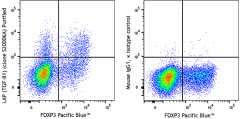- Clone
- S20006A (See other available formats)
- Regulatory Status
- RUO
- Other Names
- Latency Associated Peptide (LAP), Transforming growth factor beta 1 (TGF-b1), TGFB1, DPD1, TGF-beta1
- Isotype
- Mouse IgG1, κ
- Ave. Rating
- Submit a Review
- Product Citations
- publications

-

Human peripheral blood mononuclear cells were stimulated with PHA for 24 hours. Cells were surface stained with purified anti-LAP (clone S20006A) or purified mouse IgG1, κ followed by goat anti-mouse IgG PE. Cells were then fixed and permeabilized with FOXP3 Fix/Perm Buffer Set and stained intracellularly with FOXP3 Pacific Blue™. Data shown were gated on CD4+ population.
| Cat # | Size | Price | Quantity Check Availability | Save | ||
|---|---|---|---|---|---|---|
| 300002 | 100 µg | 151€ | ||||
TGF-β1 (transforming growth factor β1) is a multifunctional cytokine which regulates cellular proliferation and differentiation. It is ubiquitously expressed by many types of cells. Platelets express high level of TGF-β. TGF-β is synthesized as a large protein precursor and then secreted as a complex of TGF-β and LAP (latency-associated peptide), in which LAP noncovalently associates with the dimeric mature TGF-β to prevent its activity. TGF-β requires activation before it binds to its receptors and exerts functions. It has been reported that LAP-TGF-β binds to the integrins αvβ1, αvβ6, αvβ8, and α8β1 through RGD domain. TGF-β plays important roles in control proliferation and differentiation of epithelial cells, endothelial cells, fibroblasts, neurons, osteoclasts, and osteoblasts. TGF-β is believed to be important in the regulation of the development of Treg, Th17, and Th9 cells. A recent study has shown that LAP is an activated Treg surface marker.
Product DetailsProduct Details
- Verified Reactivity
- Human
- Antibody Type
- Monoclonal
- Host Species
- Mouse
- Immunogen
- Human TGF-β1 transfected cells
- Formulation
- Phosphate-buffered solution, pH 7.2, containing 0.09% sodium azide
- Preparation
- The antibody was purified by affinity chromatography.
- Concentration
- 0.5 mg/mL
- Storage & Handling
- The antibody solution should be stored undiluted between 2°C and 8°C.
- Application
-
FC - Quality tested
- Recommended Usage
-
Each lot of this antibody is quality control tested by immunofluorescent staining with flow cytometric analysis. For flow cytometric staining, the suggested use of this reagent is ≤ 0.125 µg per million cells in 100 µL volume. It is recommended that the reagent be titrated for optimal performance for each application.
- Application Notes
-
Clone S2006A can completely block the binding of clones TW4-2F8 and TW4-6H10 on target cells.
- RRID
-
AB_2892340 (BioLegend Cat. No. 300002)
Antigen Details
- Structure
- About 400 amino acids, N-terminal signal peptide is required for secretion from a cell, a pro-region (LAP) and C-terminal region that becomes the mature TGF-β molecule following its release from the pro-region by proteolytic cleavage.
- Distribution
-
Ubiquitously expressed by many kinds of cells
- Function
- Multifunctional cytokine, regulates cells proliferation, and differentiation
- Ligand/Receptor
- TGF-βRI, -RII, -RIII, CD105, LTBP, integrins
- Cell Type
- B cells, Dendritic cells, T cells, Tregs
- Biology Area
- Adaptive Immunity, Apoptosis/Tumor Suppressors/Cell Death, Cell Biology, Immunology, Inhibitory Molecules, Neuroinflammation, Neuroscience, Signal Transduction
- Molecular Family
- Cytokines/Chemokines, Growth Factors
- Antigen References
-
- Yi JJ, et al. 2010. Cell. 142:144.
- Tran DQ, et al. 2009. Blood. 113:5125.
- Lu M, et al. 2002. J Cell Sci. 115:4641.
- Khalil N. 1999. Microbes Infect. 1:1255.
- Gene ID
- 7040 View all products for this Gene ID
- UniProt
- View information about LAP on UniProt.org
Related FAQs
Other Formats
View All LAP Reagents Request Custom Conjugation| Description | Clone | Applications |
|---|---|---|
| Purified anti-human LAP (TGF-β1) | S20006A | FC |
| PE anti-human LAP (TGF-β1) | S20006A | FC |
| APC anti-human LAP (TGF-β1) | S20006A | FC |
| FITC anti-human LAP (TGF-β1) | S20006A | FC |
| PE/Cyanine7 anti-human LAP (TGF-β1) | S20006A | FC |
| TotalSeq™-A1244 anti-human LAP (TGF-β1) | S20006A | PG |
| TotalSeq™-B1244 anti-human LAP (TGF-β1) | S20006A | PG |
| TotalSeq™-C1244 anti-human LAP (TGF-β1) | S20006A | PG |
Compare Data Across All Formats
This data display is provided for general comparisons between formats.
Your actual data may vary due to variations in samples, target cells, instruments and their settings, staining conditions, and other factors.
If you need assistance with selecting the best format contact our expert technical support team.
-
Purified anti-human LAP (TGF-β1)

Human peripheral blood mononuclear cells were stimulated wit... -
PE anti-human LAP (TGF-β1)

Human peripheral blood mononuclear cells were stimulated wit... -
APC anti-human LAP (TGF-β1)

Human peripheral blood mononuclear cells were stimulated wit... -
FITC anti-human LAP (TGF-β1)

Human peripheral blood mononuclear cells were stimulated wit... -
PE/Cyanine7 anti-human LAP (TGF-β1)

Human peripheral blood mononuclear cells were stimulated wit... -
TotalSeq™-A1244 anti-human LAP (TGF-β1)
-
TotalSeq™-B1244 anti-human LAP (TGF-β1)
-
TotalSeq™-C1244 anti-human LAP (TGF-β1)
 Login / Register
Login / Register 







Follow Us